Last Updated on February 1, 2024 by foxintheforest
With crystal clear mountain lakes and rugged ridgelines, there are many reasons to hit the trails in Rocky Mountain National Park. The best hikes in Rocky Mountain National Park bring you right into the heart of this jaw-dropping landscape.
Located so close to Boulder and Denver, Rocky Mountain National Park is one of the most accessible national parks in the US. And one of the top things to do in Rocky Mountian National Park is to hit the trails!
Rocky Mountain National Park hikes cater to all abilities, from families with young kiddos to the avid peak bagger. This guide to the best trails in Rocky covers everything you need to know to hike like a local.
Since moving to Colorado 12 years ago, I’ve hiked countless trails in Rocky Mountain National Park.
In fact, I write for the outdoor industry and have put down some serious hiking miles throughout the park from gentle sunrise jaunts to full-out alpine climbs.
I’m in this park multiple times a year in a variety of conditions and locations. As an expert in all things Rocky Mountain National Park, you can get the inside scoop on the top hikes so you can visit the park like a local, not a tourist.
Get exclusive, local insight to incredible Rocky Mountain National Park trails with this mega-epic guide. So you can spend more time on the trail without the crowds.
About This Guide to the Best Hikes in Rocky Mountain National Park
As an amazing day trip near Denver, Colorado, Rocky Mountain National Park is a hiker’s paradise. We’ll cover all the top hikes in Rocky Mountain National Park. Here’s what to expect:
- The best easy hikes in Rocky Mountain National Park
- The park’s most scenic moderate Rocky Mountain National Park trails
- A list of mega-challenging Rocky Mountain National Park hikes
- Distance, elevation, difficulty, and estimated time for each hike
- Quick tips for visiting Rocky Mountain National Park
- Packing list for Rocky Mountain National Park
- Top FAQs about hiking in the park
- Additional planning resources

Where is Rocky Mountain National Park?
Rocky Mountain National Park is located in between Grand Lake and Estes Park. There are two main entrances to the park, the east and west entrance.
Local Tip: Trail Ridge Road, the high mountain pass that connects the two entrances, closes from late fall through mid-spring.
Most people opt to access Rocky Mountain National park from the east entrance, just 15 minutes from downtown Estes Park. Estes Park offers easy convenience and many of the best hikes in Rocky can be found on the east side.
What is the best hike in Rocky Mountain National Park?
The best hike in Rocky Mountain National Park is easily Mt. Ida. Not only are the views at the summit stunning, but all my fellow hikers out there will love the incredible panoramas you get as you make your way to the top.
Local Tip: Not up for the uphill challenge? Then you should check out Emerald Lake instead or explore the park by booking a Rocky Mountain National Park tour.
What is the prettiest hike in Colorado?
The prettiest hike in Colorado is Emerald Lake Trail in Rocky Mountain National Park. Not only is it home to one of the most beautiful alpine lakes in Colorado, but the hike is well-suited for people of all hiking abilities.
Plus, there are many highlights along the way which include Colorado wildflowers, alpine scenery, stunning mountains, and picturesque lakes.
Getting to Rocky Mountain National Park from Denver
If you’re planning on accessing the park from the Front Range, you’ll want to take I-25 north to Highway 36 until it ends and head west towards Lyons. From here continue along St Vrain Dr until you reach Estes Park.
From Estes, make a left onto Elkhorn Ave, then head south on Moraine Ave following signs to Rocky Mountain National Park.
Drive Time: 1 hour 45 minutes.
Getting to Rocky Mountain National Park from DIA
If you’re arriving from DIA, you’ll want to take Pena Blvd to Northwest Parkway/CO E-470 N (tolls). From there head north on I-25 towards Longmont, then head west, making your way towards Lyons.
Drive Time: 1 hr 45 mins.
Local Tip: Drive times from both Denver and DIA are rarely traffic-free – it’s best to budget around 2 hours for the trip.
Accessing Rocky Mountain National Park from the West
If you’re coming from the west (and Trail Ridge Road is open), you’ll likely want to access the park from the West Entrance near Grand Lake.
Simply head north on Highway 40 from I-70 towards Granby. From there take Highway 34 east to the park entrance.
Drive Time: Varies.

Timed Entry Requirements for Rocky Mountain National Park in 2022
In 2021 Rocky Mountain National Park is continuing their required reservation system. From May 28th to October 28th you’ll need to purchase an advanced reservation to access Rocky Mountain NP.
So, if you plan to do a bit of snowshoeing in Rocky Mountain National Park then no need to worry.
Permits cost the same as the entry fee and annual pass holders should check specific details.
There are two separate permits. One for the Bear Lake Road corridor which must be purchased if you’re entering that area of the park between 5 am and 6 pm. You can continue to enjoy the rest of the park at that time.
A second permit is available if you are NOT visiting the Bear Lake Road Corridor from 9 am to 3 pm. This permit allows you to enter the park, but not visit the Bear Lake Corridor unless you take the free shuttle.
Bear Lake Road Corridor includes the following trailheads:
- Bear Lake
- Sprague Lake
- Glacier Gorge
- Bierstadt Lake
- Hollowell Park
- and any other trailhead accessed from Bear Lake Road
Permits are released on the first of the month for the following month. Meaning you can obtain timed entry permits for July on June 1. Plan accordingly and remember, permits fill up fast!
Psst…you’ll also need to pay the $20 park entry fee to get into the park. Alternatively, get an America the Beautiful Annual Parks Pass to access all US national parks and recreation areas for a 12 month period and pay a one-time fee of $80.
Accessing the Best Hikes in Rocky Mountain National Park by Shuttle
The Bear Lake Corridor is home to some of the best hikes in Rocky Mountain National Park and typically by 5 am parking is unavailable at any of the trailheads. Yup. During the busy summer and fall seasons, parking will fill up before 5 am.
Moraine Park is another popular area that sees quite a bit of traffic too. You can also take a hiker shuttle here as well. Just keep in mind that this loop is separate from the Bear Lake Corridor shuttle.
However, you can take a free shuttle from the Estes Park Visitor Center to one of many stops along both Moraine Park and the Bear Lake Corridor.
The free shuttle runs from May 28th until October 17th from 6:30 am to 7:30 pm for both routes.
The Bear Lake Corridor shuttle leaves every 15 minutes and stops at:
- Park and ride
- Bierstadt Lake Trailhead
- Glacier Gorge Trailhead
- Bear Lake
The Moraine Park shuttle starts at the Park and Ride. Shuttles leave every 30 minutes and go to:
- Sprague Lake and Glacier Creek Stables
- Hollowell Park
- Tuxedo Park
- Moraine Park Campground (C Loop)
- Cub Lake Trailhead
- Fern Lake Trailhead
The Best Easy Hikes in Rocky Mountain National Park
If you’re new to hiking, or you’re just looking for a mellow outing, there are plenty of incredible easy hikes in Rocky Mountain National Park. Just be sure to arrive at trailheads early, since parking lots often fill up before 8 am (don’t worry, you can take a shuttle too).
1. Dream Lake
One of the biggest icons of the park (aside from the epic Long’s Peak) is Dream Lake. Arguably one of the most scenic Rocky Mountain National Park hikes, this incredibly scenic, picture-perfect hike is super easy to reach and delivers big on views. See mighty Hallet Peak and the famous Dragon’s Tail Couloir (big, snow-filled chute).
Local Tip: This is one of the best hikes in Colorado and it sees LOTS of crowds. Come for sunrise for a chance at some solitude, otherwise expect a conga line of people. The parking lot fills by 8 am even on weekdays.
Distance: 2 miles
Elevation Gain: 426
Difficulty: easy
Estimated Time: 1 hour
Trailhead: Bear Lake
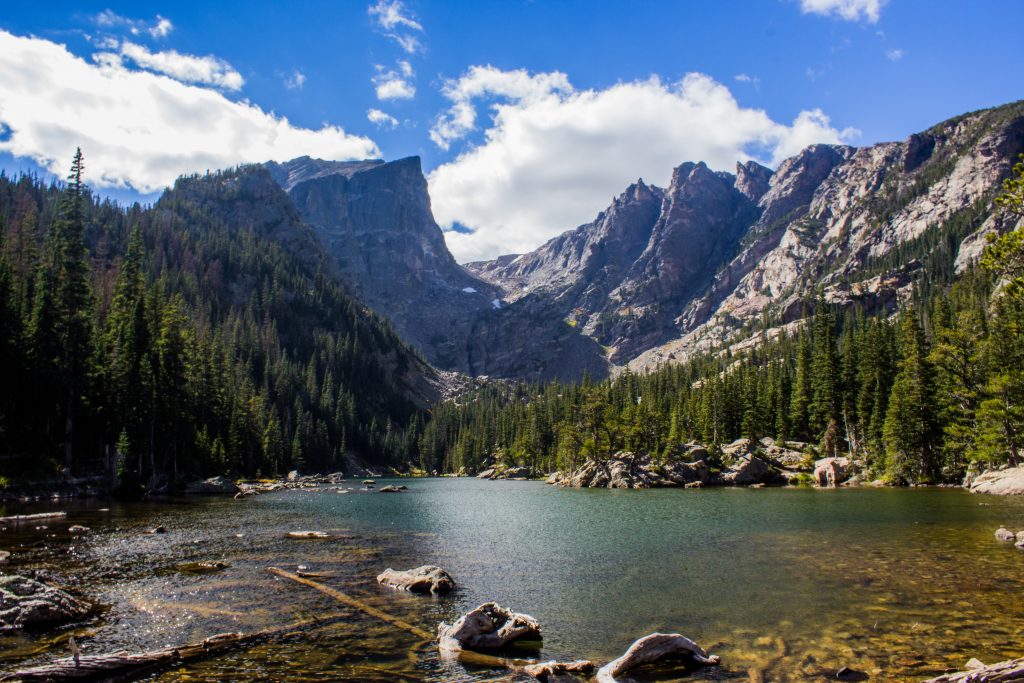
2. Emerald Lake
Continue past Dream Lake another 0.2 miles to get an even better look at the dramatic Hallet Peak. The super-famous Emerald Lake Delivers big on views. Bring your camera. If you’re looking for still waters, the early morning hours are your best bet.
Distance: 3.3 miles
Elevation Gain: 702
Difficulty: easy
Estimated Time: 2 hours
Trailhead: Bear Lake
Local Tip: This area is home to many of the best US national parks hikes, so arrive early (before 4 am) for some solitude.
3. Lake Haiyaha
This mellow hike hits over four of the best alpine lakes in Colorado – Dream Lake, Emerald Lake, Nymph Lake, and Lake Haiayaha – making it a real bang for your buck.
Reaching Dream, Nymph, and Emerald lake is pretty straightforward. After leaving the trailhead, you’ll reach the small Nymph Lake. Then you’ll hit a trail junction at Dream Lake. Continue west for a 0.4-mile round-trip detour for a stop at Emerald Lake.
Backtrack back to the junction and continue on to hike to Lake Haiyaha, the trail does get steep for a little bit, but it’s not too difficult.
Local tip: This string of lakes is one of the most beautiful winter hikes in Colorado. Arrive for sunrise for a real special treat.
Distance: 4 miles
Elevation Gain: 864
Difficulty: easy
Estimated Time: 2 hours
Trailhead: Bear Lake
4. Bear Lake
Arguably the easiest hike in Rocky Mountain National Park (next to Sprague Lake), you’ll be granted extraordinary views of Bear Lake and the nearby peaks just minutes from the parking lot. Loop the lake or head out to one of the park’s more difficult trails.
Local Tip: The Bear Lake Trail is an accessible trail in Rocky Mountain National Park, meaning it’s wheelchair and stroller friendly.
Distance: 0.7 miles
Elevation Gain: 42
Difficulty: very easy
Estimated Time: 0.5 hours
Trailhead: Bear Lake
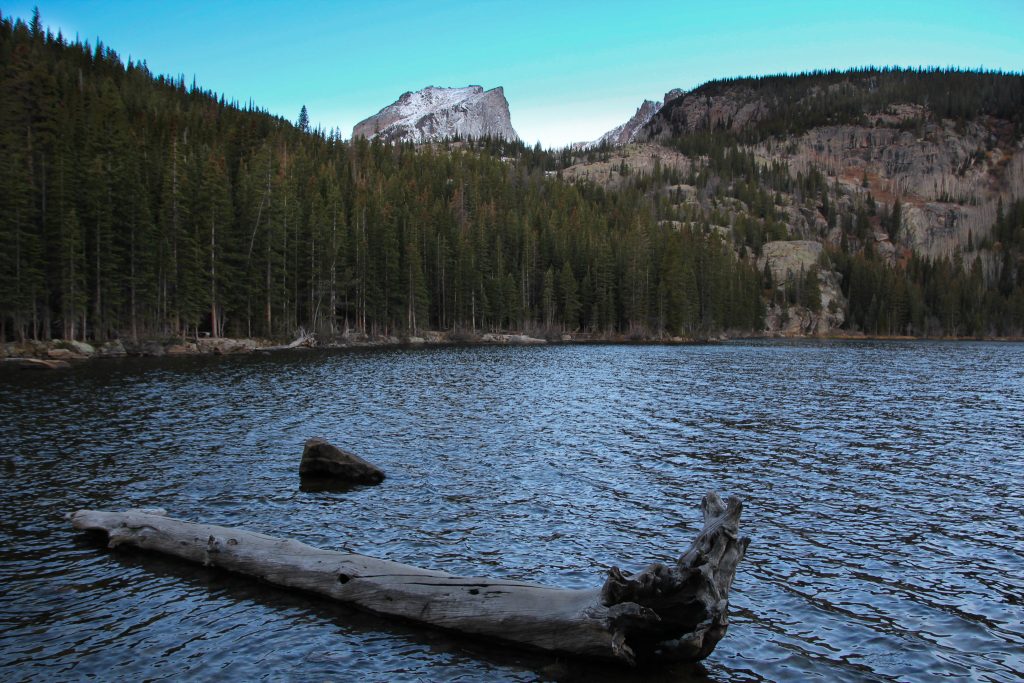
5. Alpine Ridge Trail
Visit in July when the wildflowers are blooming and you’ll be treated to a picture-perfect high alpine scene that you have to see to believe. As the easiest hike on this list above treeline, this is a must-do hike for visiting Rocky Mountain National Park.
Local Tip: Check if the trail is open, the area was recently closed in the October 2020 wildfires.
Distance: 0.7 miles
Elevation Gain: 147
Difficulty: easy
Estimated Time: 15 minutes
Trailhead: Alpine Visitor Center
6. Alluvial Fan Hike
More like a gentle stroll and less like a hike, the Alluvial Fan is still a worthwhile trip. The Alluvial Fan is a unique geological feature that formed once a damn broke upstream. The result is a large fan of boulders that you can hike to, scramble up, and catch a glimpse of a waterfall.
Local Tip: The trail to the boulder field is paved but some people report it can be a little steep for strollers and wheelchairs towards the end.
Distance: 0.5 miles
Elevation Gain: 157
Difficulty: easy
Estimated Time: 15 minutes
Trailhead: East or West Alluvial Fan Trailhead. Each are quite close to one another and have similar hiking experiences.
7. Sprague Lake
Another amazing sunrise hike option in the park, Sprague Lake is one of the best day hikes in Rocky Mountain National Park. As a stroller and wheelchair accessible hiking trail it’s a great option for the entire family.
Local Tip: If you want solitude and tranquil vibes, check this spot out for sunrise.
Distance: 0.8 miles
Elevation Gain: 32 feet
Difficulty: very easy
Estimated Time: 0.5 hours
Trailhead: Sprague Lake
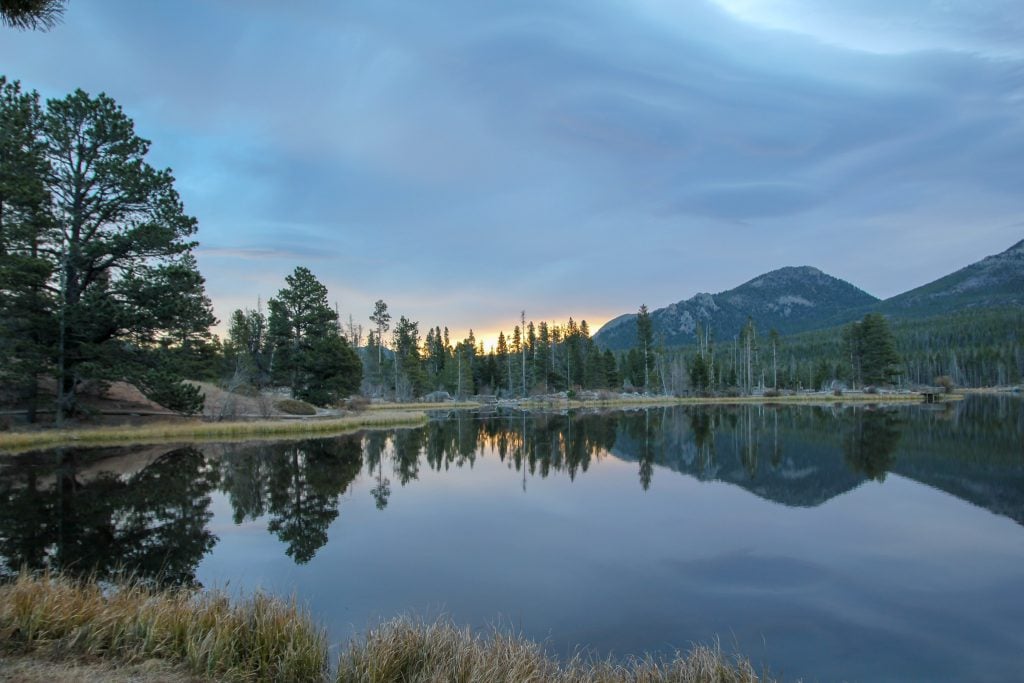
8. Alberta Falls
Located at the Glacier Gorge Trailhead parking area, the trail to Alberta falls leisurely makes its way to one of the most beautiful viewpoints in Rocky Mountain National Park. The best times to view the falls are in late May and early June when the snow runoff is at a high.
Distance: 1.6 miles
Elevation Gain: 252 feet
Difficulty: easy
Estimated Time: 1 hour
Trailhead: Glacier Gorge
9. Twin Owls and Lumpy Ridge Loop
Lumpy Ridge often gets overlooked for more popular areas of the park, but that doesn’t mean that the Twin Owls and Lumpy Ridge Loop shouldn’t be on your list. This mellow trail takes you to the Twin Owl rock sentinals, an impressive feature that really does look like a pair of hooting birds.
Local Tip: add on Gem Lake for a fun-filled morning at Lumpy Ridge, then go for a scenic drive to Trail Ridge Road for a well-rounded day in the park.
Distance: 3.6 miles
Elevation Gain: 864
Difficulty: easy
Estimated Time: 2 hours
Trailhead: Lumpy Ridge
Is the Lumpy Ridge Trailhead Inside Rocky Mountain National Park?
Yes! The Lumpy Ridge Trailhead is located in Rocky Mountian National Park. All of the same rules and regulations (including your entry fee and now timed-entry permit) must be followed.
10. Gem Lake via Lumpy Ridge
Outside of the main area of Rocky Mountain National Park, you’ll find Lumpy Ridge, one of the premier rock climbing areas in Colorado.
Climbing aside, this area has some incredible hiking trails. Far less crowded than the Glacier Gorge and Bear Lake area, you’ll find solitude amongst the huge rock formations jutting from the mountainside.
Local Tip: Lumpy Ridge is highly under-rated. In fact, it’s got some of the best hikes in Estes Park.
Distance: 3.1 miles
Elevation Gain: 990 feet
Difficulty: easy to moderate
Estimated Time: 1.5 hours
Trailhead: Lumpy Ridge
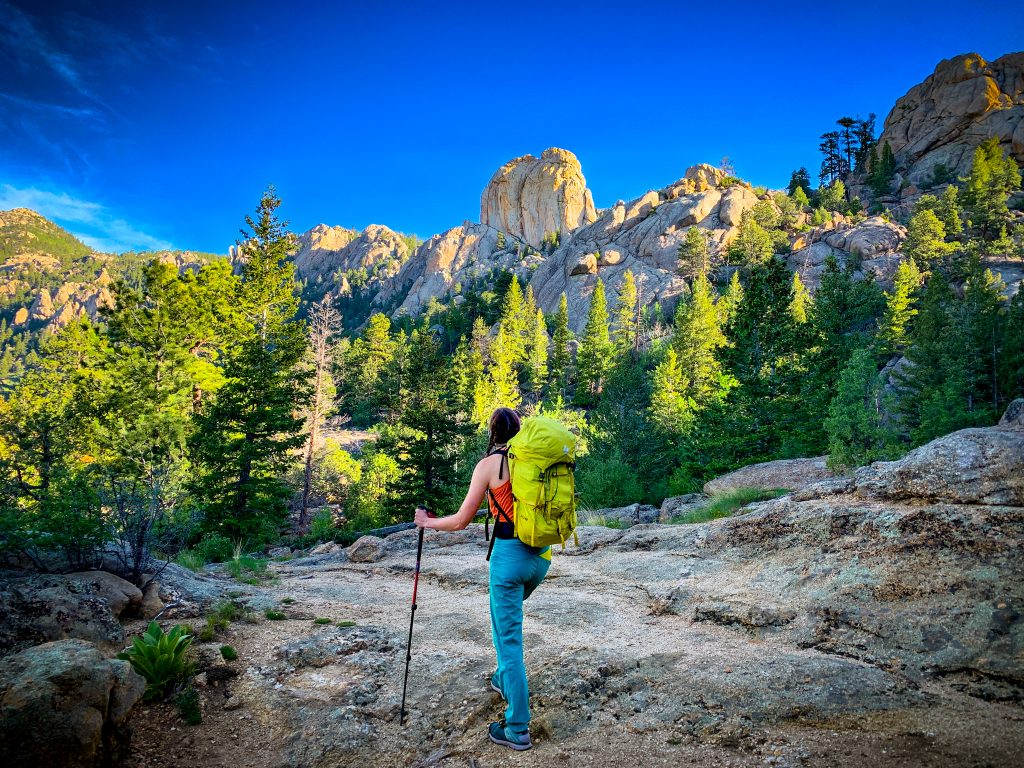
11. Glacier Gorge
You can’t talk about the best hikes in Rocky Mountain National Park without mentioning Glacier Gorge. You’ll find that lots of the hikes on this list start along Glacier Gorge.
Fortunately, for beginner hikers, Glacier Gorge is an excellent introduction to the park. The trail itself features plenty of gorgeous scenery and if you’re feeling up to it, you can connect with more difficult trails.
Distance: 2.8 miles
Elevation Gain: 403 feet
Difficulty: easy with options ranging from moderate to difficult.
Estimated Time: 1.5 hours
Trailhead: Glacier Gorge
12. Nymph Lake
Not up for the full Emeral and Dream Lake hike? Then simply head to Nymph Lake. This forested lake feels like a place where ferries hang out. The calm tranquil waters are home to lily pads and other water life. As one of the best hikes in Rocky Mountain National Park, it’s normally done in conjunction with Dream and Emerald Lake, but if you’re short on time or not into the uphill, it’s an excellent hike in it’s own right.
Local Tip: Still want more hiking? Continue onwards for about 15 more minutes (one-way) to reach the iconic Dream Lake.
Distance: 1.2 miles
Elevation Gain: 262
Difficulty: easy
Estimated Time: 40 minutes
Trailhead: Bear Lake Trailhead
What are the Best Easy Hikes in Rocky Mountain National Park?
Although hiking in the mountains can be a tougher than low-elevation trails, there are a few quick and easy hikes in RMNP. A few of the best easy hikes in Rocky Mountain National Park include:
- Bear Lake
- Dream Lake
- Alberta Falls
Moderate Hiking Trails in Rocky Mountain National Park
Most of the trails in Rocky Mountain National Park are moderate in difficulty. Compared to much of Colorado, the moderate trails are substantially easier, thanks to a stellar trail maintenance team.
13. Bridal Veil Falls
Take the Cow Creek Trail to the peaceful Bridal Veil Falls. As one of the best waterfall hikes in Colorado, this tranquil scene is a must-see. The trail makes its way along the scenic Cow Creek where you’ll hear the babbling sounds of snowmelt (even in summer). The falls feature a 20-foot cascade, which by Colorado standards is a real beauty.
Distance: 6.1 miles
Elevation Gain: 964
Difficulty: moderate
Estimated Time: 3 hours
Trailhead: Cow Creek Trailhead
14. Lake Helene and Two Rivers Lake
Scope out the epic views of Notchtop Mountain, Little Matterhorn and Flattop Mountain along this classic Rocky Mountain National Park Hike.
Follow the Bear Lake Trail then take a right towards Odessa Lake and Flattop Mountain. Continue onwards past the Sourdough Campsite and take one of the several unmarked trails on your left to reach the lake. If you make a sharp hairpin turn north (right), you’ve passed it.
Distance: 6.1 miles
Elevation Gain: 1,348 feet
Difficulty: moderate
Estimated Time: 3 hours
Trailhead: Bear Lake
15. Ute Trail to Tombstone Ridge
Ridge walking is something of a Colorado pastime and there’s no better way to experience it than hiking the Ute Trail to Tombstone Ridge. Walk an ancient path that the Ute Native Americans used to use to migrate across the area.
Local Tip: This hike is all above treeline, so do be sure that the weather is storm-free before attempting.
Distance: 5.6
Elevation Gain: 1,912
Difficulty: moderate to challenging
Estimated Time: 2.5 hours
Trailhead: Ute Crossing Trailhead
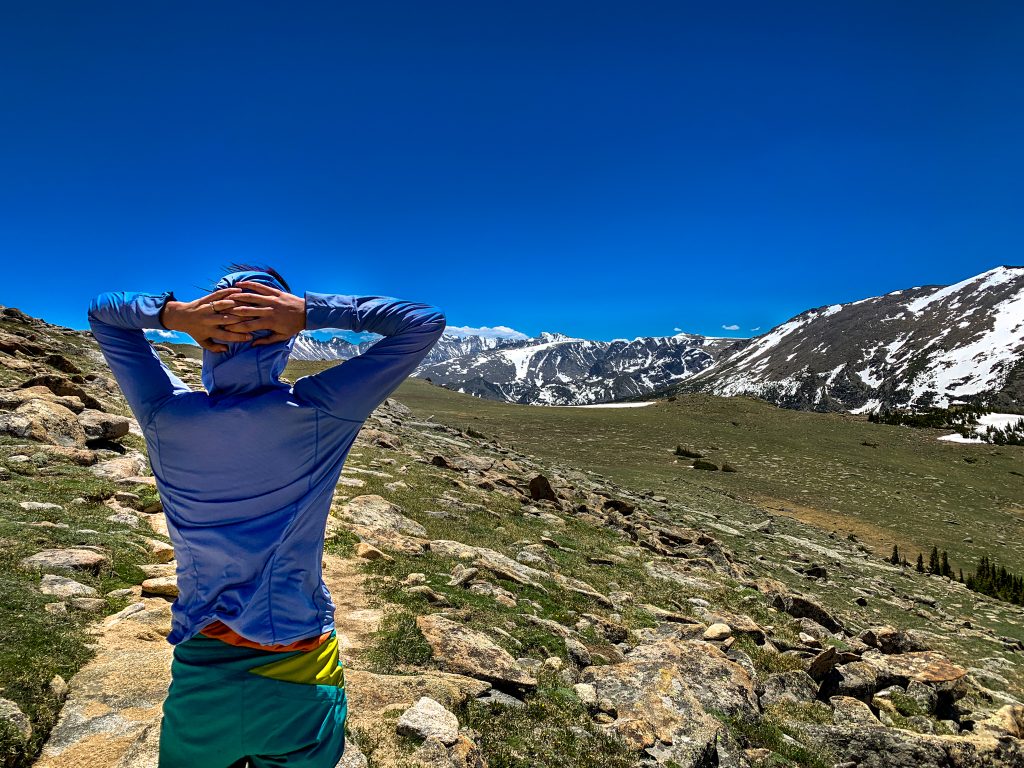
16. Copeland Falls
If you can’t get enough of cascading water, then hike up to Copeland Falls. One of the lesser-trafficked trails in the park brings you to a beautiful waterfall system nestled amongst jagged rocks. For what the falls lake in height they make up for in idyllic beauty.
Distance: 5.8 miles
Elevation Gain: 721 feet
Difficulty: moderate
Estimated Time: 3 hours
Trailhead: Wild Basin
17. Mills Lake via Glacier Gorge
Glacier Gorge has a host of amazing destinations to explore and Mills Lake might be one of my favs (along with Loch Lake, the Sharkstooth, and Sky Pond). Follow the Glacier Gorge Trail out of the parking lot following signs for Mills Lake (2 marked junctions lead the way).
Local Tip. Take a break at Alberta Falls. If you’re up for it, take a detour to The Loch on the way down (an extra 0.8 miles one-way). Or up the challenge and continue onwards to Black Lake.
Distance: 4.9 miles
Elevation Gain: 836 feet
Difficulty: moderate
Estimated Time: 2.5 hours
Trailhead: Glacier Gorge
18. Black Lake Trail
For dramatic lake views, hike out to Black Lake. The water meets sheer granite faces with this jaw-dropping alpine lake. Can you spot the Diamond, Longs Peak’s most famous face, in the distance? You can continue onwards above the lake towards the Spearhead for even more alpine scenery.
Distance: 9.7 miles
Elevation Gain: 1,643
Difficulty: moderate
Estimated Time: 4.75 hours
Trailhead: Glacier Gorge

19. Ypsilon Lake Trail
If you’re looking to ditch the crowds, head to Ypsilon Lake. One of the best-kept-secret trails in Rocky Mountian National Park, this trail boasts beauty and tranquility. It terminates at Ypsilon Lake which is at the base of its namesake’s mountain.
Distance: 10.5 miles
Elevation Gain: 3,244 feet
Difficulty: moderate to difficult
Estimated Time: 6 hours
Trailhead: Lawn Lake Trailhead
20. Fern Lake Hike
When it comes to the best hikes in Rocky Mountain National Park, Fern Lake certainly deserves a spot on the list. This awesome, moderate hike takes you to a beautiful wooded lake with all of the classic mountain views. Less crowded than some of its cousins found along the Bear Lake Corridor (but still well-loved), Fern Lake is a great addition to your Rocky Mountain National Park hiking itinerary.
Distance: 7.5 miles
Elevation Gain: 1,476 feet
Difficulty: moderate
Estimated Time: 3 hours 45 minutes.
Trailhead: Fern Lake Trailhead
21. Loch Lake Hike
As one of the best trails in Rocky Mountain National Park, Loch Lake is an excellent moderate challenge that’s jam-packed with views. Loch Lake itself is quite stunning, and a great spot to have a picnic and snap some photos. The best part about Loch Lake is you can carry onwards to Sky Pond if you’re feeling fresh.
Distance: 5.4 miles
Elevation Gain: 1,072
Difficulty: moderate
Estimated Time: 2.75 hours
Trailhead: Glacier Gorge
Related: The Best Hiking Trails in Colorado
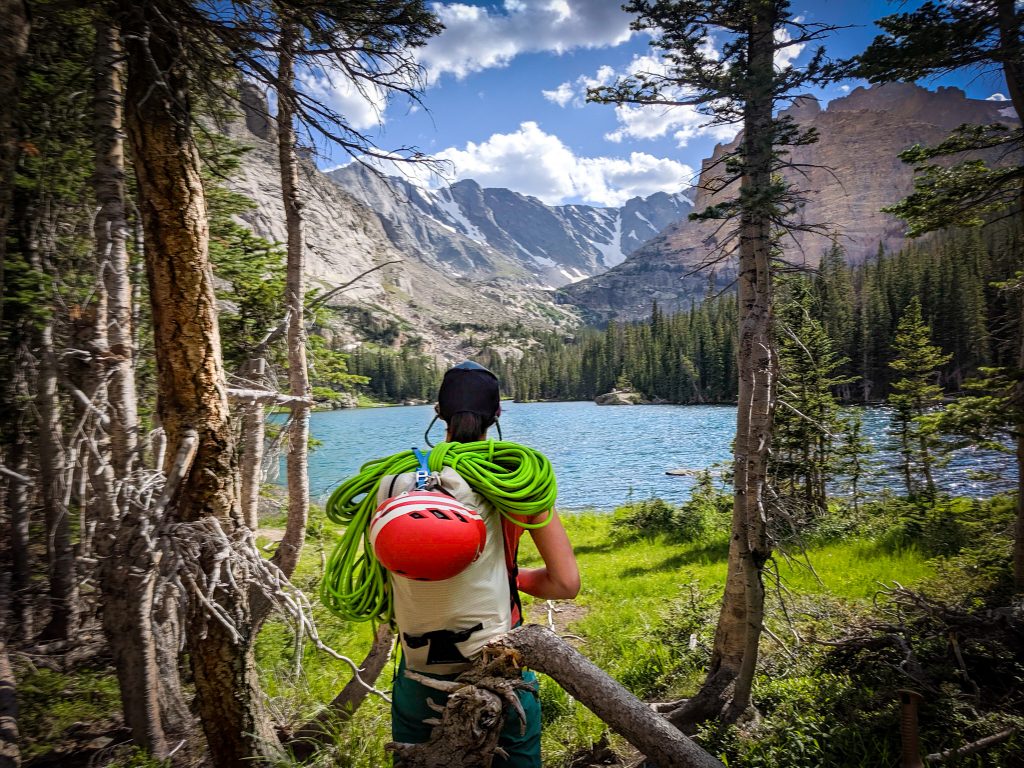
22. Ouzel Falls Hike
The Wild Basin area of the park boasts several excellent hiking trails that are away from the main drag. Ouzel Lake boasts scenic alpine views and makes for an unforgettable picnic spot.
Distance: 9.4 miles
Elevation Gain: 1,683 feet
Difficulty: moderate
Estimated Time: 4.75 hours
Trailhead: Wild Basin
23. Deer Mountain
If you’re looking for sweeping mountain views along one of the easier hikes in the park then Deer Mountain is one of the best hikes in Rocky Mountain National Park for you.
Just be prepared to continually walk uphill through vast forests filled with pine trees until you reach the summit where you’ll marvel at incredible views of Longs Peak and Moraine Valley.
So, while the hike can feel like a bit of a slog, it’s totally worth the effort for the panoramas at the top. And to access the trailhead, just take Trail Ridge Road about 3 miles west of the Beaver Meadows entrance.
Local Tip: This hike is great because it’s easy to access from Estes Park and receives a lot less foot traffic than some of the other hikes on this list. It’s also perfect for anyone new to hiking or for anyone who wants to acclimatize to the area.
Distance: 6.2 miles
Elevation Gain: 1400 feet
Difficulty: Moderate
Estimated Time: 3 or 4 hours
Trailhead: N Deer Mountain Trail
24. Twin Sisters
Head all the way out to the far eastern end of the park and check out one of the best hikes in Rocky Mountain National Park with sweeping views of Estes Park and Longs Peak from the top.
And while this isn’t the most amazing hike on this list it’s definitely a good one if you want to prepare yourself for more intense climbs like Longs Peak.
It’s also a great hike if you’re looking for a bit of solitude since not as many people use this trail.
Just be forewarned that this hike really only gets exciting at the top since most of the hike is spent trekking through dense forests.
Local Tip: This trail is popular among local runners so keep an eye out for them.
Distance: 7.4 miles
Elevation Gain: 2516 feet
Difficulty: Moderate
Estimated Time: 4 or 5 hours
Trailhead: Twin Sisters Trailhead
25. Odessa Lake
If you’re looking for one of the best hikes in Rocky Mountain Park that is relatively devoid of people then give the trek to Odessa Lake a try.
Plus. it can be paired with an onward hike to Fern Lake and gives you the chance to see some of the awesome alpine lakes that the park is known for.
That being said, there are other alpine lake hikes in the park that you should do first, like Sky Pond and Emerald/Dream Lake.
You also have a couple of different ways to hike to both Fern Lake and Odessa Lake. You could hike out and back to Fern Lake or point-to-point between Fern Lake and Odessa Lake. Just start at Bear Lake before finishing at Moraine Park.
Distance: 7.5 to 10 miles depending on your route
Elevation Gain: 2004 feet
Difficulty: Moderate
Estimated Time: 4 or 5 hours
Trailhead: Bear Lake Trailhead
The Most Challenging Hikes in Rocky Mountain National Park
As a hiker’s paradise, RMNP has an endless array of extraordinarily challenging hiking objectives. These hikes are for seasoned mountain hikers only and should be taken seriously. Many of the top hikes in Rocky Mountain National Park are real challenges for any mountain hiker.
26. Flattop Mountain Trail
If you love hiking Colorado mountains but want to skip the crowds on Colorado’s famous 14ers, then take on the challenge of hiking Flattop Mountain. It’s surely a grind, but the views from the top are well worth the effort.
Local Tip: If you’re not up for the grind to the top of Hallet Peak, but still want views down onto Dream and Emerald Lakes, this is the trail for you.
Distance: 8.2 miles
Elevation Gain: 2,870 feet
Difficulty: Difficult
Estimated Time: 6 hours
Trailhead: Bear Lake
27. Sky Pond via Glacier Gorge Trail
This is arguably one of the best lake hikes in Colorado and absolutely a top trail in Rocky Mountain National Park. If you’re up for a challenge and willing to use your hands, you’ll love the Sky Pond hike.
Most of the hike is relatively mellow, until the end where you’ll hike directly up a creek bed. You’ll be scrambling and will need your hands.
Pro Tip: This trail becomes quite dangerous in the winter, special gear is required so be sure to check trail conditions before heading out in the colder months.
Distance: 8.2 miles
Elevation Gain: 2,870
Difficulty: Difficult
Estimated Time: 4.5 hours
Trailhead: Glacier Gorge

28. Mt Ida
Set out on a summit bid with a hike up Mount Ida (12,865′). This walk-up summit is a great way to test your strength and see if you’re ready to tackle bigger peaks. Head along the Ute Trail until the marked junction and keep right.
Spanning views of the Continental Divide, Mummy Range, and nearby Gore Range adds to the drama. But you’ll earn it, the trail is steep with stairs along the way.
Local Tip: Since October of 2020 this trail is closed.
Distance: 9.3 miles
Elevation Gain: 2,362 feet
Difficulty: difficult
Estimated Time: 5 hours
Trailhead: Ute Crossing Trailhead
29. Chasm Lake
If you are up for a challenging hike but don’t want to summit a mountain, Chasm Lake is a world-class hiking trail. It’s one of the most scenic Rocky Mountain National Park hikes, featuring the second biggest granite rock wall in the country.
Terminating at the rocky alpine lake, you’ll be right at the base of the Diamond, a prominent and dramatic slice of granite that is one of the world’s most coveted climbing objectives. The way up isn’t easy and is riddled with steep elevation gains and switchbacks.
Distance: 9.4 miles
Elevation Gain: 2,601 feet
Difficulty: difficult
Estimated Time: 5 hours
Trailhead: Longs Peak Trailhead
30. Scrambling Longs Peak
Longs Peak is one of the most famous Colorado 14ers. It certainly isn’t the easiest Colorado 14er, in fact, it requires scrambling skills and prior mountain summits before attempting. You’ll need a helmet and a stomach for exposure to hike this challenging route.
Local Tip: There are lots of things to know before hiking a Colorado 14er, but the most important tip of all is to start early. Plan to be below treeline by noon to avoid getting caught in a life-threatening thunderstorm.
Distance: 14.9 miles
Elevation Gain: 4,911 feet
Difficulty: difficult to expert
Estimated Time: 10 hours
Trailhead: Longs Peak Trailhead
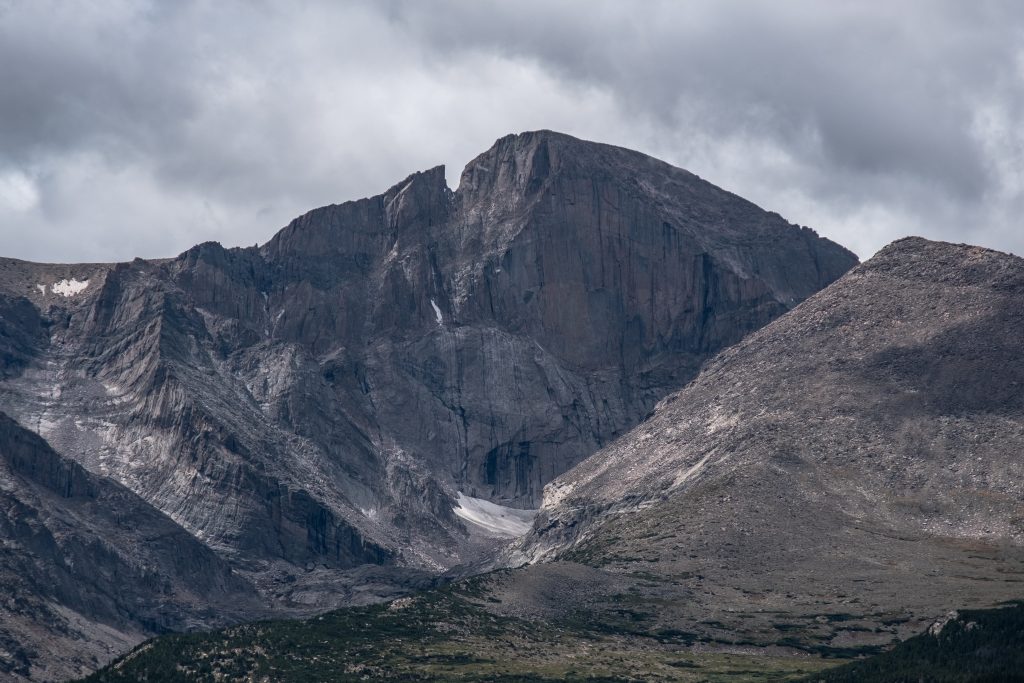
31. Hallet Peak
Hike to the top of Hallet Peak and score a bird’s eye view of the iconic Dream Lake and Emerald Lake. Grind up the butt-busting trail along the east ridge of Hallet Peak and stand 12,720 feet tall!
Distance: 10.3 miles
Elevation Gain: 3,293
Difficulty: difficult
Estimated Time: 5.5 hours
Trailhead: Bear Lake
32. The Mummy Kill
More of a trail running suffer-fest than a leisurely hike and should only be attempted by well-seasoned mountain hikers and trail runners.
The Mummy Kill refers to a slog-a-thon challenge that goes over the 6 peaks in the Mummy Range. Not to mention after you summit Mummy Mountain, you’ll be bushwhacking through dense trees for several miles before stumbling onto the Lawn Lake Trail. from there it’s another 5 miles to the car.
PHEW. I’m exhausted just typing that. It’s a serious objective that commands respect and many people train for years just to attempt it.
Distance: 20 miles
Elevation Gain: 5,600
Difficulty: Expert
Estimated Time: 11 hours
Trailhead: Long Lake Trailhead. You’ll need a shuttle since this is a one-way route. Park another car at the Fall River Entrance Station.
What is the Hardest Hike in Rocky Mountain National Park?
If you’re looking for a true challenge, you can find in Rocky. The hardest hike in Rocky Mountain National Park that most people know about is the Keyhole Route on Long’s Peak. However, this isn’t really a hike. You’ll be climbing (not hiking) up a mountain. You’ll need a helmet and plenty of Colorado 14ers under your belt before safely tackling this route.
Another challenging hike in Rocky Mountain National Park is the Mummy Kill. This 20-plus-mile gauntlet is for uber-experienced hikers and trail runners ONLY. You’ll need to be confident navigating off-trail, understand mountain weather hazards, and be able to move fast and light.
Map of Hikes in Rocky Mountain National Park
Here’s an interactive map of Rocky Mountain National Park hikes.

When is the Best Season for Hiking in Rocky Mountain National Park?
The best time of year to hike in Rocky Mountain National Park is from late June until October.
Keep in mind that July and early August are the monsoon season. This is when dangerous and life-threatening thunderstorms take over in the mountains.
Storms usually show up quickly and violently by noon so always check the weather before hitting the trail.
You can certainly enjoy Rocky Mountain National Park trails year-round, but keep in mind that many trails have avalanche hazards in the winter and Trail Ridge Road is completely closed. Beginner winter hikers should have an avalanche safety education before heading out.
Related: Awesome Things to Do in Rocky Mountain National Park this Winter

Quick Tips for Visiting Rocky Mountain National Park
As a mountain hiking expert, I know a thing or two about hiking in the Rockies. Before hitting the trail, be sure to read my guide to hiking in Colorado. You’ll find loads of safety tips and information about what to expect in the alpine.
When it comes to making the most of Rocky Mountain National Park hikes, there are a few location-specific tips to keep in mind:
Check Road Conditions
Many of the roads close in the winter and trails can be inaccessible with snow. Always check with the ranger station for the latest conditions.
Purchase a Parks Pass and Plan in Advance
If you plan on visiting the park for multiple days, consider buying a parks pass, it might be cheaper and it will get you into a variety of national parks and monuments across the US.
Popular Parking Lots Fill Up Before Sunrise
Parking lots fill up super early in RMNP – especially for any trails at Glacier Gorge, Bear Lake, or Long’s Peak.
If you’re there after 8 am, plan on taking the bus to get around. You can snag the shuttle at the Park and Ride near the Glacier Basin Campground. Shuttle service is from 8 am to 5 pm.
Leave No Trace
As always, keep it better than you found it. Pack out your trash (even apple cores, TP, and orange peels), don’t harass or approach wildlife, stay on the trail.
Chase the Sunrise
Go for a sunrise hike. Sunrise is the absolute best time to go for a hike in Rocky Mountain NP. The most crowded trails in Rocky Mountain fill up very quickly. If you want any chance at solitude or a quiet trail, plan on putting on that headlamp and starting before the sun rises!
Local Tip: Most people hike at about 30 minutes per mile or 1 hour per 1,000 foot of gain. If you want to be at your hiking destination by sunrise, use the stats on the above hikes to plan accordingly!
Pack a Picnic!
Bring a packed lunch. If you plan on being in the park all day, food is limited. Heading out of the park and back in again will invalidate your time slot, so to make the most of one day in Rocky Mountian National Park, pack a cooler filled with snacks, lunch items, and plenty of water.
Acclimatize Properly
If you’re coming from lower elevations, you may struggle a bit with the change in altitude. Plan a down day for your first day in Colorado. Drink plenty of water and tackle an easy, mellow hike to get used to the altitude. Eating foods that are rich in garlic can help you get used to the high altitude. Avoid alcohol and caffeine for faster acclimatizing.
Watch the Weather
The Colorado weather – particularly in the mountains – can be wild, unpredictable, and dangerous. The summer monsoons bring quick and violent thunderstorms to the mountains. These storms kill hikers every year who are unprepared. Rocky Mountain National Park has a higher number of deaths from lightning strikes because so many people flock to the park.
Plan your hike to avoid thunderstorms by using a tool like weather.gov to check the exact trail, lake, or landmark you’re heading to. Aim to be below treeline (the highest elevation that trees grow) before 11 am to avoid storms. Never hike above treeline in a thunderstorm.
Never Approach or Feed Wildlife
Many different animals call Rocky Mountain National Park home. From bears to elk and even moose there are plenty of creatures who wander the trails. Your best chance at spotting wildlife is actually early in the morning before the throngs of people scare the animals from the trail.
Never approach wildlife. In general, you want to keep at least 100 yards of distance between you and an animal. Elk and moose charge tourists every year in Estes Park.
Don’t feed small critters like chipmunks, marmot, and pika. Your food is not a natural part of their diet. When you feed these animals you do a lot of harm to their digestive tract. Not to mention, you encourage them to be bold and chew through your hiking pack.
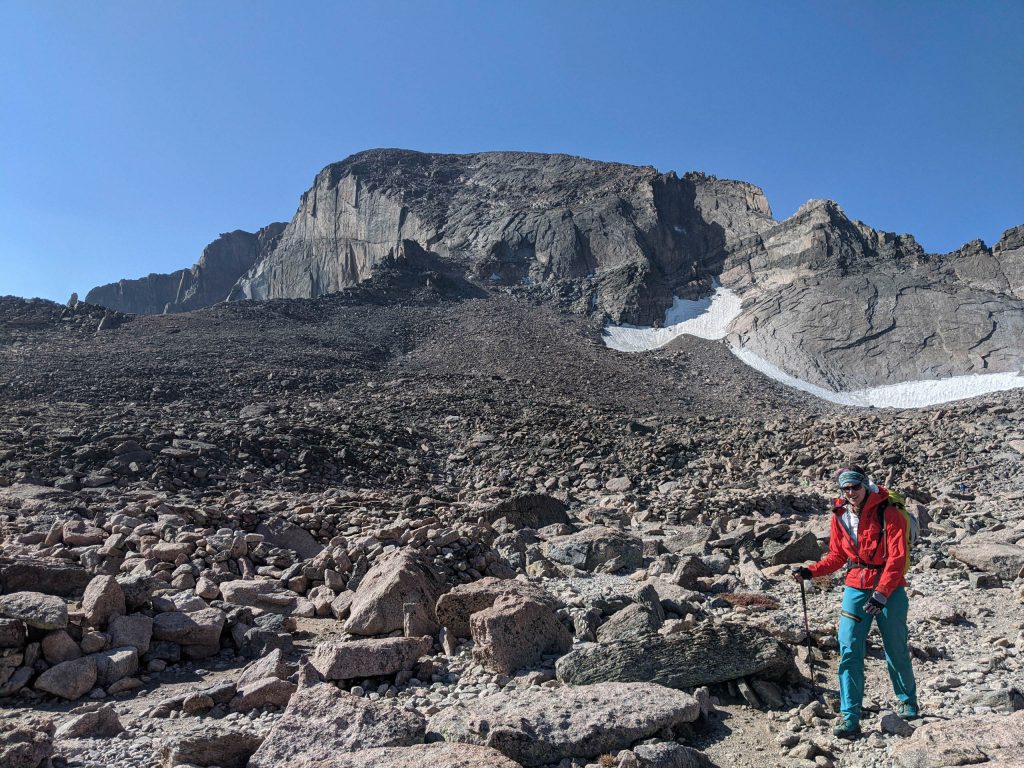
Use Trailhead Toilets or Pack Out Your Toilet Paper
Toilet paper and human waste is a huge problem in Rocky Mountain National Park. Always use toilets at trailheads when possible. But if you do have to go on the trail, be sure to be 70 adult steps away from the trail or any water source. Bury your business in a 6-inch cathole. Then pack out your used toilet paper. Animals dig it up and it’s unsightly at the trail.
Leave Fido at Home
Rocky Mountain National Park is not dog-friendly. In fact, your dog cannot leave the pavement, meaning they are pretty much confined to the car. In the summer, mountain temps can get quite hot and give your dog heat stroke. Just leave your pup at home if you plan on hiking in Rocky Mountain National Park.
What to Pack for Rocky Mountain National Park Hikes
Hiking in the mountains requires a bit of extra preparation – especially when it comes to what to take with you. Thanks to varying weather, intense sun, and high altitude mean you’ll want to be prepared.
Even though Rocky Mountain National Park hikes can be quite popular, if something were to go wrong, rescue services can take hours to reach you. Here’s what you’ll need to bring for your Rocky Mountain National Park Hike.
What to wear:
- Sunshirt
- Noncotton socks
- Hiking footwear with good traction that you are comfortable wearing all day.
- Non-cotton shorts for hiking
- Or non-cotton, pants for hiking. Convertible pants are great too!
- Non-cotton shirt for hiking
What to pack:
- Hiking day pack. I love the REI Flash 22 for an affordable day pack.
- Water and snacks for the car – it’s always nice to have a treat at the end!
- Sunscreen, sunhat, sunglasses
- First Aid Kit
- Electrolyte powder – optional but nice to have!
- A water bladder capable of carrying at least 2 liters of water.
- Camera
- Camera clip to strap to your back
- Beanie
- Glove liners
- Fleece layer
- Puffy layer
- Hiking poles (optional)
- A toilet kit: shovel, WAG Bag (if you plan to travel above treeline), hand sanitizer, TP/baby wipes, a small plastic baggy to pack out TP and sanitary items
- Pee funnel – optional
- Pee rag – optional.
- Headlamp
- GPS navigation
- emergency communication device
- Wind/rain layer
- Pocket knife
What is the Best Hike in Rocky Mountain National Park?
When it comes to the best hike in Rocky Mountain National Park, there is no one single answer. It largely depends on what you’d like to see and how challenging you’d like your hike to be.
Emerald Lake is the best hike in Rocky Mountain National Park for water lovers. You’ll pass three distinct lakes along the way. For more of a challenge check out Sky Pond or Chasm Lake.
For those that want a bird’s eye view, Hallet Peak is an excellent choice. This challenging butt-buster doesn’t require any special skills, but will certainly challenge your legs and lungs!
If you have plenty of mountain hiking experience, know how to scramble (low-grade rock climb without ropes), and aren’t afraid of butt-puckering exposure, then the Keyhole Route on Long’s Peak is right for you.
What is the Hardest Hike in Colorado?
There are several immensely challenging hikes in Colorado and you can find a few of them in Rocky Mountain National Park. Many people argue that Long’s Peak Keyhole Route is the toughest hike in Colorado, however, to call this trail a hike is a bit of a misnomer. You need expert mountain hiking experience, rock scrambling abilities (meaning you’ll be using your hands climbing up over exposed rocks), and a helmet to make this journey.
Another hot contender is the Colorado Trail – at over 486 miles it takes about a month to complete, making it the longest hike in Colorado. It’s also one of the highest elevation thru-hikes in the country.
What Should You Not Miss in Rocky Mountain National Park?
When it comes to visiting Rocky Mountain National Park, there are several places you’ve got to explore. A few hot spots you don’t want to miss include:
- Dream Lake and Emerald Lake
- Trail Ridge Road
- Chasm Lake
- Lumpy Ridge
Planning a Trip to Colorado? I’ve got you covered with these related articles:
- 10 Colorado Backpacking Trips You’ve Got to Try
- The Only Colorado Road Trip Itinerary You’ll Ever Need
- Tips for Visiting Colorado


